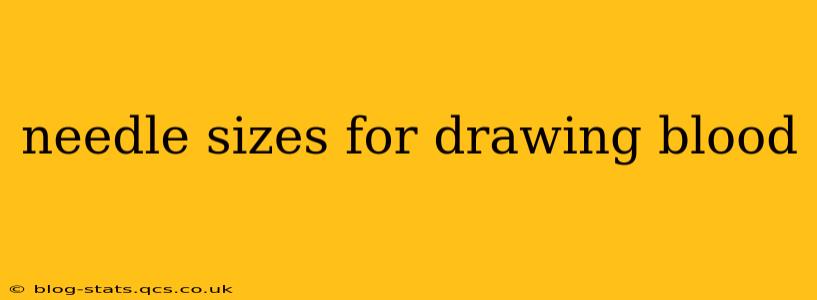Drawing blood is a common medical procedure, but choosing the right needle size is crucial for patient comfort and the integrity of the blood sample. This guide will delve into the specifics of needle gauges for venipuncture, addressing common questions and concerns.
While there's no single "best" needle size for all situations, the most commonly used gauges for venipuncture fall within a specific range, with factors like patient vein size and the type of blood test influencing the final decision.
What are the Standard Needle Sizes for Blood Draws?
The standard needle sizes used for drawing blood are typically expressed in gauge numbers. A lower gauge number indicates a larger diameter needle, while a higher gauge number indicates a smaller diameter needle. The most frequently used gauges for venipuncture range from 21 gauge to 23 gauge.
-
21 Gauge: This is a relatively large-diameter needle, often preferred for patients with larger, more easily accessible veins. It's suitable for most blood collection procedures.
-
22 Gauge: A commonly used all-purpose size, striking a balance between ease of insertion and minimizing patient discomfort.
-
23 Gauge: This is a smaller-diameter needle, often chosen for patients with smaller or more fragile veins, particularly elderly patients or children. It minimizes the risk of hematoma (bruising).
While 21, 22, and 23 gauge are the most common, you might encounter 20 gauge needles for blood donation or specific blood tests requiring a larger volume of blood. Conversely, needles smaller than 23 gauge are less common due to increased risk of hemolysis (rupture of red blood cells).
What Needle Size is Best for Difficult Veins?
Finding a suitable vein can be challenging in some patients. For patients with difficult veins, a smaller gauge needle, such as a 23 gauge, might be preferred to minimize trauma and the risk of vein collapse. Using a butterfly needle with a 23-gauge needle can also be beneficial as it allows for greater flexibility in accessing difficult veins.
What Needle Size is Best for Children?
When drawing blood from children, a smaller gauge needle like a 23 gauge or even a 25 gauge is generally preferred to minimize pain and discomfort. The choice of needle size will always depend on the child’s age and vein size; a medical professional will make this determination.
What Happens if the Wrong Needle Size is Used?
Using an incorrectly sized needle can lead to several negative consequences:
- Hematoma: Using too large a needle can cause significant trauma to the vein, leading to bruising and swelling.
- Hemolysis: Using a needle that's too small can damage red blood cells, leading to inaccurate test results.
- Pain and discomfort: The wrong size needle can cause unnecessary pain and discomfort for the patient.
- Vein collapse: Too large a needle can cause the vein to collapse, making it difficult or impossible to obtain a sample.
What other factors influence needle size selection?
Beyond the patient's vein size, several other factors influence the choice of needle size for blood collection:
- Type of test: Certain blood tests require larger volumes of blood, necessitating the use of a larger gauge needle.
- Blood viscosity: If the blood is highly viscous, a larger needle might be helpful to ensure smooth flow.
- Individual phlebotomist preference: While guidelines exist, experienced phlebotomists may develop preferences for specific needle sizes based on their experience.
Disclaimer: This information is for educational purposes only and should not be considered medical advice. Always consult with a qualified healthcare professional for any medical questions or concerns. The selection of the appropriate needle size for blood collection should always be made by a trained medical professional based on individual patient assessment.
